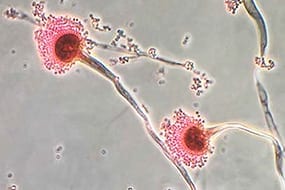Funtabulously Frivolous Friday Five 205
Just when you thought your brain could unwind on a Friday, you realise that it would rather be challenged with some good old fashioned medical trivia FFFF, introducing the Funtabulously Frivolous Friday Five 205
Question 1
Meigs Syndrome resolves after removal of the tumour. What is the classic triad of Meigs Syndrome?
Reveal the funtabulous answer
The triad of ascites, pleural effusion and a benign ovarian tumour (ovarian fibroma, fibrothecoma, Brenner tumour, and occasionally granulose cell tumour).
Named after Joe Vincent Meigs (1892-1963) an American obstetrician and gynaecologist who described Meigs syndrome in 1934.
Question 2
Aspergillus was first catalogued in 1729 by the Italian priest and biologist Pier Antonio Micheli. Viewing the fungi under a microscope, Micheli was reminded of the shape of an aspergillum (holy water sprinkler), from Latin spargere (to sprinkle), and named the genus accordingly.
What are the five main diseases aspergillum can produce in humans?
Reveal the funtabulous answer
- Sinusitis.
- Allergic bronchopulmonary aspergillosis – a condition characterised by an exaggerated response of the immune system to the Aspergillus. It occurs most often in patients with asthma or cystic fibrosis.
- Aspergilloma, a “fungus ball” that can form within cavities such as the lung.
- Invasive aspergillosis – spreads throughout the body.
- Extrinsic allergic alveolitis (malt workers lung) – from mouldy barley leading to a Type III hypersensitivity and type IV hypersensitivity.
Question 3
A male presents to you with recurrent chest infections, otitis media, infertility and quiet heart sounds on the left side of his chest. What genetic disease does he have?
Reveal the funtabulous answer
Primary ciliary dyskinesia (or Kartagener syndrome).
It is a rare, ciliopathic, autosomal recessive disorder that causes defects in the action of cilia lining the respiratory tract (lower and upper, sinuses, Eustachian tube, middle ear), fallopian tube and flagella of the sperm cell.
Siewert first described the classic triad of situs inversus, chronic sinusitis and bronchiectasis in 1904.
However, Manes Kartagener (1897 – 1975) first recognized this clinical triad as a distinct congenital syndrome in 1933. Because Kartagener described this syndrome in detail, it bears his name.
Question 4
What is the relevance of the myth of Prometheus to cirrhosis of the liver?
Reveal the funtabulous answer
Prometheus was chained to a mountain and every eagle would visit him and eat his liver as punishment from the Olympian Gods for having given fire to humankind. Everyday his liver would grow back.
What has this got to do with cirrhosis? There are many causes (many eagles), the liver has considerable powers of regeneration (it grows back), and it is often traced back to something that in retrospect really wasn’t a very good idea – such as excessive alcohol consumption, IV drug abuse or sex (giving fire to humankind)… Credit: Tim Koelmeyer
Question 5
How is Calabar (in modern times, a city in Nigeria) related to Argyll Robertson pupils?
Reveal the funtabulous answer
Douglas Argyll Robertson (1837–1909) was consulted by a patient who lived in ‘Old Calabar’ about the ‘Calabar swellings’ that affected her eyes.
He extracted filiarial Loa loa worms from these lumps and was thus one of the first to describe Ocular Loiasis.
References
- Shah AN. Ocular Loiasis. N Engl J Med 2010; 363:e16
- Douglas Argyll Robertson (1837–1909)

FFFF
Funtabulously Frivolous Friday Five
Dr Neil Long BMBS FACEM FRCEM FRCPC. Emergency Physician at Kelowna hospital, British Columbia. Loves the misery of alpine climbing and working in austere environments (namely tertiary trauma centres). Supporter of FOAMed, lifelong education and trying to find that elusive peak performance.



